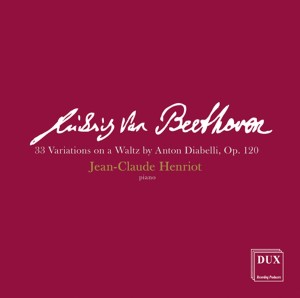Jean-Claude Henriot begins the Beethoven Diabelli Variations’ opening waltz theme by imposing a small yet slightly arch tenuto on the upbeat to the first measure. This gesture alone gives the rest of the performance away. The pianist seemingly scrutinizes every phrase, every voicing, and every tempo modification as if each variation were a laboratory specimen pickled in formaldehyde, as opposed to a component of a larger living organism.
Take the fifth variation’s enervated repeated-note patterns, for example, or notice how the pianist beats No. 9’s pesante phrases to pedantic effect. No. 13’s humorous “question and answer” character goes for nothing on account of Henriot interpreting Beethoven’s Vivace marking as “Slow and Ham-fisted”. In No. 15, Henriot brings the left hand more to the fore than usual, yet his prosaically square, under-tempo reading is anything but Presto scherzando. Nor does his contorted, slow motion No. 18 come anywhere near Poco moderato. At least No. 21’s contrasting tempos convey differing profiles, while in No. 22 the pianist’s outsize dynamics and arguably exaggerated tenutos illuminate the sardonic subtext of Beethoven’s quote from Mozart’s “Notte e giorno faticar”.
While Henriot shapes the minor-key triptych Variations 29, 30, and 31 with care and sensitivity, the mood is undone by his stern, martellato treatment of No. 32’s fugue. The concluding Minuet variation brings Henriot’s slow and studied game plan back into focus, but with a hint of graciousness in the delicate descending chords.
I can’t say that I find Henriot’s intellectualized deliberation more fulfilling than the cumulative drama that distinguishes my favorite recorded Diabelli Variations practitioners Artur Schnabel, Rudolf Serkin, Charles Rosen, Claudio Arrau, Stephen Kovacevich, and Daniel Shapiro. Still, if Henriot’s approach holds appeal, you’ll find a lighter overall touch and more finesse throughout Piotr Anderszewski’s similarly conceived traversal.
































